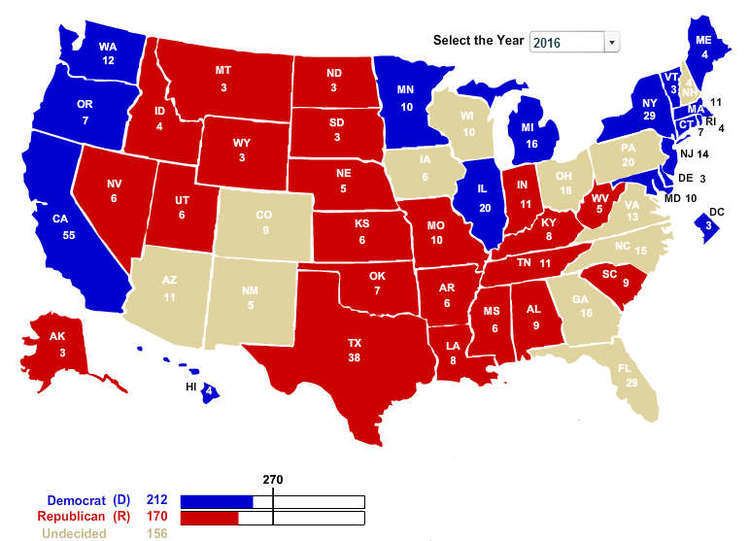 | ||
Swing state official trailer 2016 taryn manning elaine hendrix comedy movie hd
In American politics, the term swing state refers to any state that could reasonably be won by either the Democratic or Republican presidential candidate. These states are usually targeted by both major-party campaigns, especially in competitive elections. Meanwhile, the states that regularly lean to a single party are known as safe states, as it is generally assumed that one candidate has a base of support from which they can draw a sufficient share of the electorate.
Contents
- Swing state official trailer 2016 taryn manning elaine hendrix comedy movie hd
- Swing states explained in 90 seconds
- Background
- Competitive states
- Determining swing states
- Historical swing states
- Criticism
- References
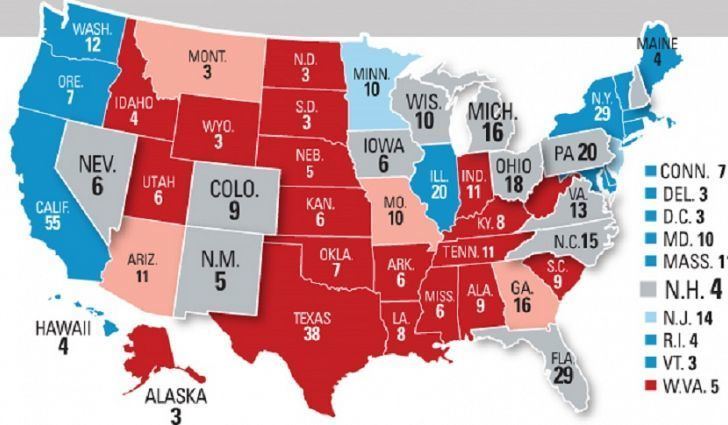
Due to the winner-take-all style of the Electoral College, candidates often campaign only in competitive states, which is why a select group of states frequently receives a majority of the advertisements and partisan media. The battlegrounds may change in certain election cycles, and may be reflected in overall polling, demographics, and the ideological appeal of the nominees. Election analytics website FiveThirtyEight identifies the states of Colorado, Florida, Iowa, Michigan, Minnesota, Ohio, Nevada, New Hampshire, North Carolina, Pennsylvania, Virginia, and Wisconsin as "perennial" swing states that have regularly seen close contests over the last few presidential campaigns.
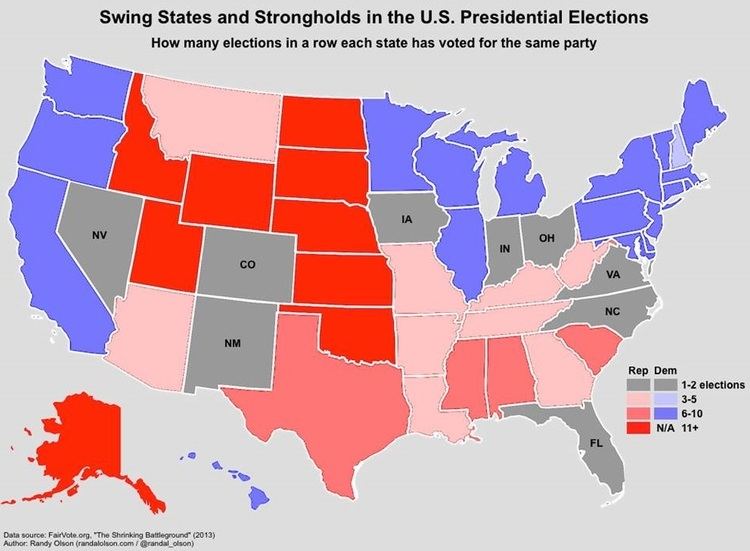
Swing states explained in 90 seconds
Background
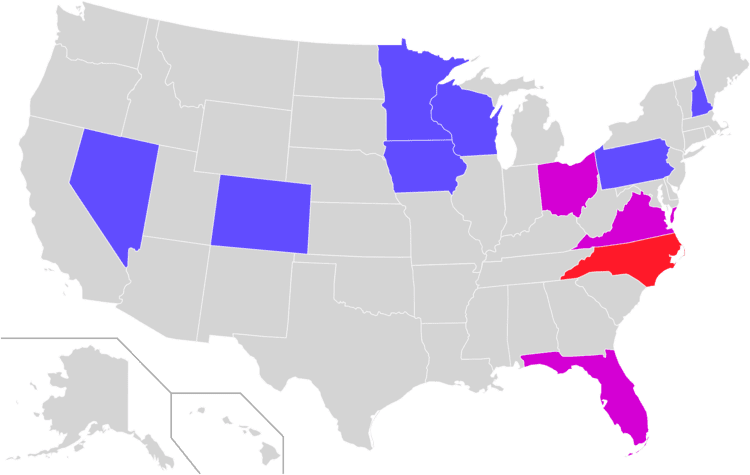
In American presidential elections, each state is free to decide the method by which its electors to the Electoral College will be chosen. To increase its voting power in the Electoral College system, every state, with the exceptions of Maine and Nebraska, has adopted a winner-take-all system, where the candidate who wins the most popular votes in a state wins all of that state's electoral votes. The expectation was that the candidates would look after the interests of the states with the most electoral votes. However, in practice, most voters tend not to change party allegiance from one election to the next, leading presidential candidates to concentrate their limited time and resources campaigning in those states that they believe they can swing towards them or stop states from swinging away from them, and not to spend time or resources in states they expect to win or lose. Because of the electoral system, the campaigns are less concerned with increasing a candidate's national popular vote, tending instead to concentrate on the popular vote only in those states which will provide the electoral votes it needs to win the election, and it is quite common for a candidate to secure sufficient electoral votes while not having won the national popular vote, such as in the case of the 2016 presidential election. From past electoral results, a Republican candidate can expect to easily win most of the northern mountain states, such as Idaho, Wyoming, the Dakotas, Montana, Utah, Kansas, Oklahoma, and Nebraska, while a Democrat usually takes the New England states, including Vermont, Massachusetts, Rhode Island, and Connecticut.
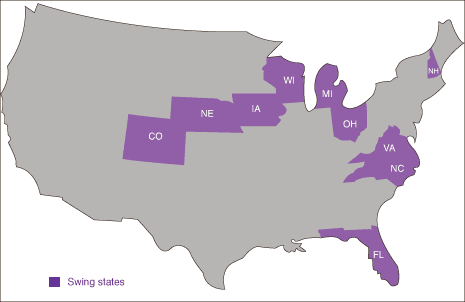
In Maine and Nebraska, the apportionment of electoral votes parallels that for Senators and Congressional Representatives. Two electoral votes go to the person who wins a plurality in the state, and a candidate gets one additional electoral vote for each Congressional District in which they receive a plurality. Both of these states have relatively few electoral votes – a total of 4 and 5, respectively. Neither Maine, which is generally considered a Democratic-leaning state, nor Nebraska, typically thought to be safely Republican, would become battlegrounds in the event of a close national race. Despite their rules, only once has each state 'split' its electoral votes – in 2008, when Nebraska gave 4 votes to Republican John McCain, and one to Democrat Barack Obama; and in 2016, when one of Maine's congressional districts was won by Donald Trump, and the other district and the state itself were won by Hillary Clinton.
Competitive states
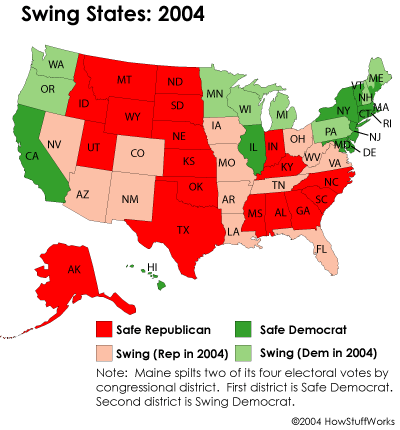
States where the election has a close result become less meaningful in landslide elections. Instead, states which vote similarly to the national vote proportions are more likely to appear as the closest states. For example, the states in the 1984 election with the tightest results were Minnesota and Massachusetts. A campaign strategy centered on them, however, would not have been meaningful in the Electoral College, as Democratic nominee Walter Mondale required victories in many more states than Massachusetts, Republican Ronald Reagan still would have won by a large margin.
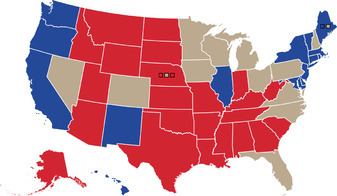
Instead, the closest state that year was Michigan, as it gave Reagan the decisive electoral vote. The difference in Michigan was nineteen percentage points, quite similar to Reagan's national margin of eighteen percent. Michigan would have been more relevant to the election results had the election been closer. Similarly, Barack Obama's narrow victory in Indiana in the 2008 election inaccurately portrays its status as a battleground. Obama lost Indiana by more than ten percentage points in the closer 2012 election, but triumphed despite losing less Republican states as North Carolina, Arizona, Georgia, Missouri, and Montana.
In 2012, the states of North Carolina, Florida, Ohio, and Virginia were decided by a margin of less than five percent. However, none of them were considered the tipping-point state, as Romney would not have been able to defeat Obama even if he had emerged victorious in all of them. Rather, Colorado was most in-step with the rest of the country. Coloradans voted for Obama by just over five percent, which was closer to Obama's national margin than those of any other contested state. Had the election come out closer, Romney's path to victory would probably have involved also winning Wisconsin, Nevada, New Hampshire, or Iowa, as these states had comparable margins to Colorado, and had been battlegrounds during the election.
As many mathematical analysts have noted, however, the state voting in a fashion most similar to that of the nation as a whole is not necessarily the tipping-point. For example, if a candidate wins only a few states but does so by a wide margin, while the other candidate's victories are much closer, the popular vote would likely favor the former. However, although the vast majority of the states leaned to the latter candidate in comparison to the entire country, many of them would end up having voted for the loser in greater numbers than did the tipping-point state. The presidential election in 2016 was a notable example, as it featured one of the largest historical disparities between the Electoral College and popular vote. As the election was quite close, the winner of the Electoral College did not capture the popular vote. Additionally, this "split" was lot larger in both directions than in previous, tighter elections, such as the one that took place in the year of 2000. In that election, Vice President Al Gore won the popular vote by less than 1 percent, while incoming president George W. Bush won the Electoral College by only 4 votes. In contrast, 2016 Democratic nominee Hillary Clinton won the popular vote by over 2 points. This meant that Donald Trump would have picked up New Hampshire, Nevada, and Minnesota if the popular vote had been tied, assuming a uniform shift among the battleground states. On the other hand, Clinton would have had to win the popular vote by at least 3 points in order to win the Electoral College, as Trump, the Republican nominee, won the tipping-point state of Wisconsin by less than 1 percent.
Determining swing states
Professor Joel Bloom has mentioned opinion polls, previous election results, media attention, candidate campaign stops, and major advertising buys as crucial factors in identifying swing states. A 2004 article in the Oregon Daily Emerald also cites movie director Leighton Woodhouse opining that there is a general consensus among most groups regarding a majority of the states typically thought of as swing states.
A broad pundit consensus regarding the status of future battleground states developed in the years following the 2012 presidential election. Contributors included Larry Sabato's Crystal Ball, Nate Silver of FiveThirtyEight, and other electoral analysts. From the results of recent presidential elections, a general conclusion was reached that the Democratic and Republican parties start with a default electoral vote count of about 190 each. In this scenario, the twelve competitive states are Wisconsin, Pennsylvania, New Hampshire, Minnesota, Ohio, Iowa, Virginia, Florida, Michigan, Nevada, Colorado, and North Carolina. However, this projection was not specific to any particular election cycle, and assumed similar levels of support for both parties.
Historical swing states
The swing states of Ohio, Connecticut, Indiana, New Jersey and New York were key to the outcome of the 1888 election. Likewise, Illinois and Texas were key to the outcome of the 1960 election. Florida and New Hampshire were key to the 2000 election. Ohio was the key to the 2004 election. Ohio has gained a reputation as a swing state since the 1980s, and last voted against the winner in the 1960 election.
Criticism
The electoral college encourages political campaigners to focus on these swing states while ignoring the rest of the country. States in which polling shows no clear favorite are usually inundated with campaign visits, television advertising, get-out-the-vote efforts by party organizers and debates, while "four out of five" voters in the national election are "absolutely ignored," according to one assessment.
Since most states use a winner-takes-all arrangement, in which the candidate with the most votes in that state receives all of the state's electoral votes, there is a clear incentive to focus almost exclusively on only a few undecided states. In contrast, many states with large populations such as California, Texas, and New York, have in recent elections been considered "safe" for a particular party, and therefore not a priority for campaign visits and money. Meanwhile, twelve of the thirteen smallest states are thought of as safe for either party – only New Hampshire is regularly a swing state, according to critic George Edwards. Additionally, campaigns stopped mounting nationwide electoral efforts in the last few months near/at the ends of the blowout 2008 election, but rather targeted only a handful of battlegrounds.
Proponents of the Electoral College claim that adoption of a national popular vote would shift the disproportionate focus to large cities while ignoring rural areas. Candidates might also be inclined to campaign hardest in their base areas to maximize turnout among core supporters. In some cases, they may also see greater opportunities in gaining votes from districts heavily supporting their opponent, the effects of which many feel would come at the expense of those in more closely divided parts of the country. Proponents of direct popular vote argue that the disproportionate influence the electoral college system affords swing states in determining the outcome of elections is unfair and essentially undemocratic.
